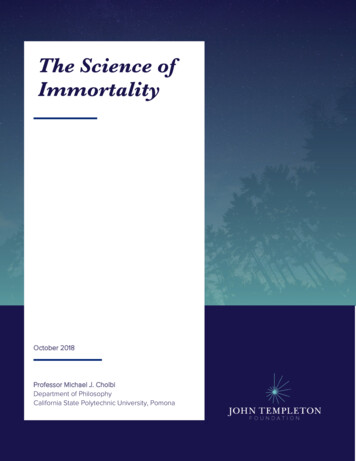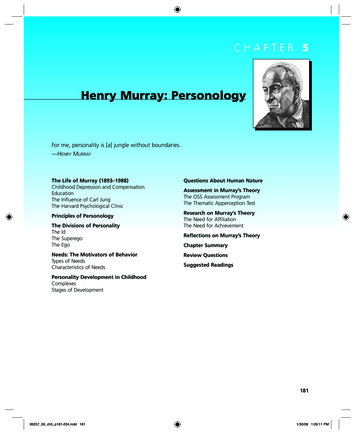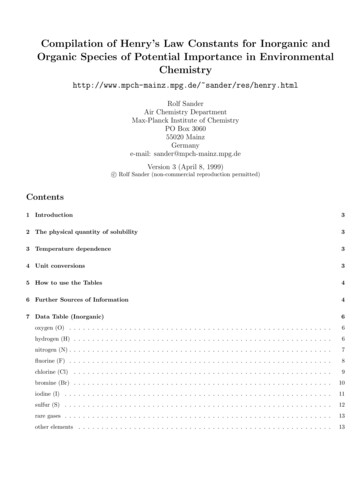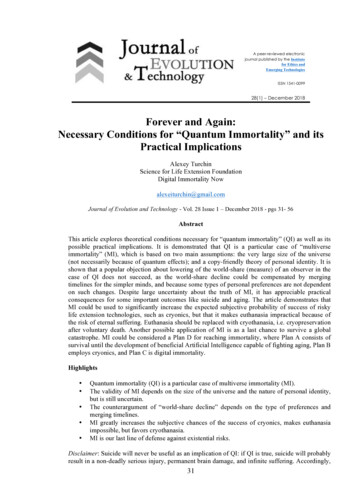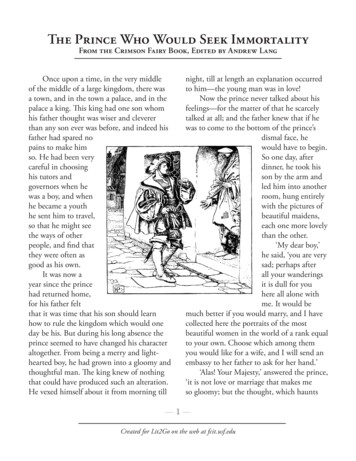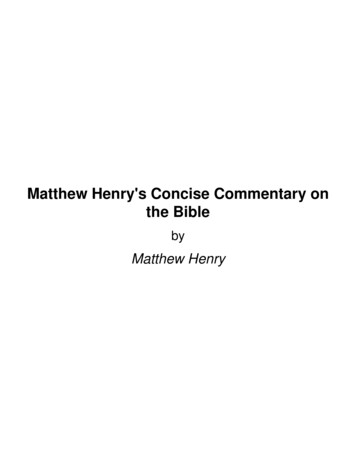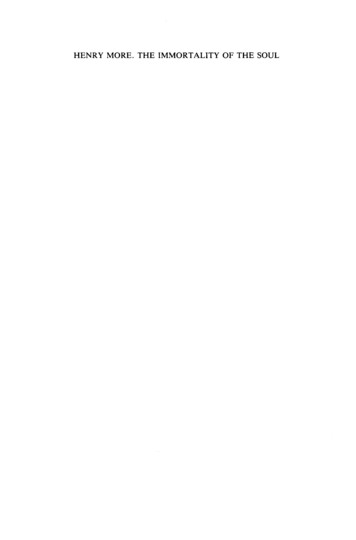
Transcription
HENRY MORE. THE IMMORTALITY OF THE SOUL
ARCHIVES INTERNATIONALES D'HISTOIRE DES IDEESINTERNATIONAL ARCHIVES OF THE HISTORY OF IDEAS122ALEXANDER JACOB(editor)HENRY MORE.THE IMMORTALITY OF THE SOULDirectors: P. Dibon (Paris) and R. Popkin (Washington Univ., St. Louis)Editorial Board: J.F. Battail (Uppsala); F. Duchesneau (Montreal); T. Gregory (Rome);J.D. North (Groningen); M.J. Petry (Rotterdam); Ch.B. Schmitt (Warburg Inst., London).Advisory Editorial Board: J. Aubin (Paris); J. Collins (St. Louis Univ.); P. Costabel (Paris); A. Crombie (Oxford); H. de la Fontaine Verwey (Amsterdam); H. Gadamer (Heidelberg); H. Gouhier (Paris); K. Hanada (Hokkaido University); W. Kirsop (Melbourne);P.O. Kristeller (Columbia Univ.); Elisabeth Labrousse (Paris); A. Lossky (Los Angeles);J. Malarczyk (Lublin); E. de Olaso (C.LF. Buenos Aires); J. Orcibal (Paris); WolfgangRod (Munchen); J. Roger (Paris); G. Rousseau (Los Angeles); H. Rowen (Rutgers Univ.,N.J.); J.P. Schobinger (Zurich); G. Sebba (Emory Univ., Atlanta); R. Shackleton (Oxford); J. Tans (Groningen).
HENRY MORE.THE IMMORTALITYOF THE SOULEdited byA. JACOB1987MARTINUS NIJHOFF PUBLISHERS .a member of the KLUWER ACADEMIC PUBLISHERS GROUP ,DORDRECHT / BOSTON / LANCASTER
Distributorsfor the United States and Canada: Kluwer Academic Publishers, P.O. Box 358,Accord Station, Hingham, MA 02018-0358, USAfor the UK and Ireland: Kluwer Academic Publishers, MTP Press Limited,Falcon House, Queen Square, Lancaster LAI lRN, UKfor all other countries: Kluwer Academic Publishers Group, Distribution Center,P.O. Box 322, 3300 AH Dordrecht, The NetherlandsLibrary of Congress Cataloging in Publication DataISBN-13:978-94-0l0-8112-2DOT: -4Copyright 1987 by Martinus Nijhoff Publishers, Dordrecht.Softcover reprint of the hardcover 15t edition 1987All rights reserved. No part of this publication may be reproduced, stored in aretrieval system, or transmitted in any form or by any means, mechanical,photocopying, recording, or otherwise, without the prior written permission ofthe publishers,Martinus Nijhoff Publishers, P.O. Box 163, 3300 AD Dordrecht,The Netherlands.
Horatio:Hamlet:o day and night, but this is wondrous strange!And therefore as a stranger give it welcome.There are more things in heaven and earth, Horatio,Than are dreamt of in your philosophy.Hamlet, Act I, Sc. V, 11.164-167.To Horatio.
PrefaceThe significance of Henry More's vitalist philosophy in thehistory of ideas has been realized relatively recently, as thebibliography will reveal. The general neglect of the CambridgePlatonist movement may be attributed to the common prejudicethat its chief exponents, especially More, were obscure mysticswho were neither coherent in their philosophical system norattractive in their prose style. I hope that this modern editionof More's principal treatise will help to correct this unjust impression and reveal the keenness and originality of More'sintellect, which sought to demonstrate the relevance of classicalphilosophy in an age of empirical science. The wealth oflearning -- ranging as it does from Greek antiquity to 17thcentury science and philosophy -- that informs More' sintellectual system of the universe should, in itself, be a recommendation to students of the history of ideas. Though, forthose in search of literary satisfaction, too, there is notwanting, in More's style, the humour, and grace, of a manwhose erudition did not divorce him from a sympatheticunderstanding of human contradictions. As for More'selaborate speculations concerning the spirit world in the finalbook of this treatise, I think that we would indeed be justified inregarding their combination of classical mythology amdscientific naturalism as the literary and philosophicalcounterpart of the great celestial frescoes of the Baroquemasters.*In the preparation of this edition, I am indebted to theDepartments of Philosophy, Classics, and English of thePennsylvania State University for the valuable learning Iderived from them. Particularly, Prof. Emily Grosholz andProf. Michael Kiernan helped me with many suggestions on thephilosophical and textual aspects of this edition. I should alsolike to thank the two readers for Martinus Nijhoff for theirperspicacious comments on my edition.My thanks are due also to Prof. Charles Mann, Mrs.Noelene Martin and Mrs. Grace Perez of the PennsylvaniaState University Library, and to the Librarians of ColumbiaUniversity Library, the New York Academy of Medicine
Library, the Folger Renaissance Library, and the Library ofCongress, for their kindness in facilitating my research. Thefigure of the brain from Charles Singer's transcription ofVesalius' De Humani Corporis Fabrica that I have used in myIntroduction is reproduced by courtesy of the Wellcome MedicalHistorical Museum, London.Finally, I must thank Mrs. P. M. Sawchuk for heroicallytyping the manuscript of this edition, and Mr. ThomasMinsker, of the University Computation Center, for his expertassistance in printing it.University Park, PennsylvaniaJuly,1986Alexander Jacob
ContentsINTRODUCTIONBiographical IntroductionThe intellectual background of The Immortality of the SoulXlThe composition and reception of The Immortality of theXXXIXSoulAnalysis of The Immortality of the SoulxlixI. More and HobbesIilxviiiII.More and DescartesII.More and NeoplatonismlxxixTextual IntroductionxcivTEXTI.II.III.IV.V.VI.Epistle DedicatoryPrefaceBook IBook IIBook IIIContents142277191309NOTESCommentary NotesTextual Notes328439Bibliography447
Biographical IntroductionBut for the better Understanding of all this, we areto take . our Rise a little higher and to premisesome things which fell out in my Youth; if not also inmy Childhood itself. To the End that it may morefully appear that the things which I have written,are not any borrowed, or far-fetch'd Opinions, owingunto Education and the Reading of Books; but theproper Sentiments of my own Mind, drawn andderived from my most intimate Nature -- HenryMore, Preface to Opera Omnia (1679) 1The intellectual individuality which characterized HenryMore, the principal representative of the group of Platonistphilosophers that distinguished the University of Cambridge inthe middle of the seventeenth century, 2 is evidenced in theearliest stages of his life. More was born at Grantham inLincolnshire, and was baptized at the parish church,St.Wulfram's, on October 10, 1614. 3 His father, AlexanderMore, was a Calvinist,and was alderman and, later,mayor ofGrantham for several years. Henry More was the seventh sonof Alexander More and, from his childhood, he displayed an"anxious and thoughtful genius" which manifested itself in aconsiderable proficiency in French and Latin at GranthamSchool as well as a keen sensitivity to the Platonic harmony ofSpenser's poetry, which his father read to him "entertaining uson winter nights, with that incomparable Peice of his, the Fairy1 Tr. Richard Ward in The Life of the learned and pious Dr. Henry More, ed.M. F. Howard, London:Theosophical Publishing Co., 1911, p. 58.2 Of the other Cambridge Platonists, the most important are BenjaminWhichcote (1609-1683), John Smith (1618-1652), and Ralph Cudworth (1617 -1688).3 The Parchment Roll at Grantham, entitled 'A true Certificate of all suchas were baptized in the Parish Church of Grantham, Anno Domini 1614'indicates the baptism date of Henry More thus "October 10, Henry theSonne of Mr.[Alexanderl More" ( Folio Register Parchment). See A.B.Grosart, The Complete Poems of Dr. Henry More, Edinburgh, 1878, rpt. N.Y.:AMS Press, 1967, p.xiin.
11INTRODUCTIONQueen, a Poem as richly fraught with divine Morality asPhansy. ,,4 This humanistic temperament could not bereconciled with the harsh doctrine of predestination which hisCalvinist upbringing had forced upon him, and already by thetime of his entry to Eton (1627 or 1628), he was revoltingagainst it. He remembers in his autobiographical sketch thathe vehemently disputed against the Calvinist interpretation offate that his paternal uncle, 5 who accompanied him to Eton,imposed on the words of Epictetus," ayE IlE d) ZEU Kat O"U "IlltEltPWIlEVT],',6 until his uncle had to threaten him with the rod forhis "immature Forwardness in philosophizing concerning suchmatters. " For, indeed, as he says, "I had such deep A versionin my Temper to this Opinion, and so firm and unshaken aperswasion of the Divine Justice and Goodness, that on acertain Day, in a Ground belonging to Aeton College, where theBoys us'd to play, and exercise themselves, musing concerningthese Things with my self . I did seriously and deliberatelyconclude within. myself viz; 'If I am one of those that arepredestinated unto Hell, where all Things are full of nothingbut Cursing and Blasphemy, yet will I behave myself therepatiently and submissively towards God; and if there be anyone Thing more than another, that is acceptable to him, thatwill I set myself to do with a sincere Heart, and to the utmostof my Power': Being certainly persuaded that if I thusdemeaned my self, he would hardly keep me long in thatPlace.,,7 Opposed to the frightening God of Calvin, More wasinbred with a more spiritual awareness of Divinity, an"exceeding hail and entire Sense of God, which Nature herselfhad planted deeply in me. ,,8This "boniform faculty" in him, as he was to call it later 94 More, "To his dear Father Alexander More, Esquire," in Grosart, op.cit.,p. 4.5 This was probably Gabriel More D.D. who, in March 1631-2, wasinstalled Prebendary of Westminster, see Grosart, op. cit., p.xn.6 "Lead me, 0 Jupiter, and thou, Fate."7 Ward, op. cit., p. 59.8 Ward, op.cit., p. 60.g cf. Enchiridion Ethicum, Bk I, Ch. 5, Art. 7: "Wherefore as it is now plain,that something there is which of its own nature, and incontestably is true.
INTRODUCTIONwas allowed to develop rapidly at Cambridge which he enteredin 1631. Masson, in his Life of John Milton, presents a piquantevocation of More's arrival at Christ's in the last year ofMilton's residence there: "Among the new admissions atChrist's, besides a Ralph Widdrington, afterwards of some noteas a physician, a Charles Hotham, and others whosesubsequent history might be traced, there was one youth atwhcm Milton, had he foreseen what he was to be, wouldcertainly have looked with more than common attention. Thiswas a tall thin sapling, of clear olive complexion, and a mildand rapt expresion, whose admission into the College isrecorded in the entrybook thus:December 31,1631 -- Henry More, son of Alexander,born at Grantham in the County of Lincoln, groundedin letters at Eton by Mr. Harrison, was admitted, inthe 17th year of his age a lesser pensioner under Mr.Gell. 10This new student, whose connexion with Christ's thus beganjust as that of Milton was drawing to a close, was the HenryMore afterwards so famous as the Cambridge Platonist, and somemorable in the history of the College. 11 More was especiallyfortunate in being tutored by Robert Gell, whom he describes as"a Person both learned and pious and, what I was not a littlesollicitous about, not at all a Calvinist." 12 Gell was a friend ofSo is there somewhat which of its own nature is simply good. Also that asthe former is comprehended by the Intellect, so the sweetness and delightof the latter is relished by the Boniform Faculty. (Tr.Edward Southwell inAn Account of Virtue; or, Dr.Henry More's Abridgement of Morals,put intoEnglish, London, 1690, p. 31).10 This is an English rendering of the original Latin:"Decemb. 31, 1631Henricus More, Filius Alexander, natus Granthamiae in agro Lincolinensiliteris institutus Etonae a M ro Harrison, anna aetatis 17. admissus estPensionarius minor sub M ro Gell." (Grosart,op. cit., p. xv)11 David Masson, The Life of John Milton, London: Macmillan, 1881, I:248f.iii
ivINTRODUCTIONthe liberal divine Joseph Mede, (who, until his death in 1638,was a very influential figure in the College) and was, evenmore than Mede, interested in the Cabala and Hermetism. Itis quite probable that, as Geoffrey Bullough conjectures, hecontributed to the development of similar esoteric interests inthe young More. 13 The intimate connection in More's mindbetween Divinity and Nature is seen in his account of the"mighty and almost immoderate Thirst after Knowledge" whichdominated him as a student, especially for "that which wasNatural; and above all others, that which was said to drive intothe deepest Cause of Things, and Aristotle calls the first andhighest Philosophy, or Wisdom . For even at that Time, theKnowledge of natural and divine Things seem'd to me thehighest Pleasure and Felicity imaginable." 14This enthusiasm for philosophy led him first to the studyof Aristotle and Cardano and Scaliger, but he was quicklydisillusioned with their teachings, which seemed to him "eitherso false or uncertain, or else so obvious and trivial, that Ilooked upon myself as havin! plainly lost my time in theReading of such Authors. ,,1 By the time of taking hisbachelor's degree in 1635, he was beginning to ponder seriously"whether the Knowledge of things was really that SupremeFelicity of Man; or something Greater and more Divine was;Or, supposing it to be so, whether it was to be acquired by suchan Eagerness and Intentness in the reading of Authors, andcontemplating of Things; or by the Purging of the Mind from allsorts of Vices whatsoever; Especially having begun to read nowthe Platonick Writers, Marsilius Ficinus, Plotinus himself,Mercurius Trismegistus, and the Mystical Divines, amongwhom there was frequent mention made of the Purification Qfthe Soul, and of the Purgative Course that is previous to theIlluminative." 16 More was also deeply influenced by themediaeval mystical work attributed to Tauler, or disciple of his,Theologia Germanica which had been edited and popularized by12 Ward, op. cit., p. 61.13 Bullough, Philosophical Poems of Henry More, Manchester, 1931, p. xv.14 Ward, op. cit., p. 6215 Ward, op. cit., p. 63.16 Ibid., p. 64f.
INTRODUCTIONLuther, and which detailed the process of spiritual purification.However, although More may have been encouraged in hisPlatonic and mystical learning by Mead, Gell, and BenjaminWhichcote -- the influential Platonist Puritan of EmmanuelCollege who was appointed Sunday Afternoon Lecturer inTrinity Church in 1636 and, later, Provost of King's College in1644 -- More was indeed the first to undertake a detailedphilosophical study of Neoplatonism. The young More'sextraordinary enthusiasm for Platonist learning is evident fromthe fact he was the first to possess a copy of Plotinus at Cambridge. As he himself declares in his letter of December27,1673 to Rev. E. Elys, "I bought one copy of Plotinus when Iwas a Junior Master for 16 shillings and I think I was the firstthat had either the luck or the courage to buy him." 17Whichcote, who used to be considered the founder of the Cbridge Platonist movement l8 , was never deeply philosophical,and the incidental Platonism of his sermons can scarcely becompared to the elaborate Neoplatonic metaphysics that Morereconstructed from the ancients in his Psychodia Platonica,which is, indeed, the first major philosophical document of themovement. 19The Psychodia Platonica was the literary culmination ofMore's spiritual efforts to achieve mystical enlightenment, "amore full Union with this Divine and Celestiall Principle, theinward flowing Wellspring of Life eternal." These efforts seem,indeed, to have been successful, for, as he reports, "When thisinordinate Desire after the Knowledge of things was thusallay'd in me, and I aspir'd after nothing but this sole Purityand Simplicity of Mind, there shone upon me daily a greaterAssurance than ever I could have expected, even of thosethings which before I had greatest Desire to know. Insomuchthat within a few years, I was got into a most Joyous and17 More, Letters on SeveraL Subjects, London, 1694, p. 27.18 See J. D. Roberts' book on Whichcote, From Puritanism to Platonism inSeventeenth Century EngLand, The Hague: Martinus Nijhoff, 1968.19 See C. A. Staudenbaur's convincing refutation of Robert's championingof Whichcote as the father of the Cambridge Platonists in his reviewarticle ,"Platonism, Theosophy and Immaterialism: Recent views of theCambridge Platonists," JHI, ( 1974), 157-63.v
VIINTRODUCTIONLucid State of Mind, and such plainly as is ineffable . .,20 Thisstate of intellectual radiance he immediately recorded in a shortpoem called Eunopla (which answered an earlier poemexpressing his spiritual perplexity, called Anopia) However,the first major fruit of his Neoplatonic enlightenment was thelong poem called 'Psychozoia, or the Life of the Soul,' which hecomposed in 1640, probably while he was a non·regent M.A. atthe the college 21 and before he was elected Fellow and Tutor ofChrist's -- a position he occupied for the rest of his life. 22 Laterfollowed companion pieces, 'Psychathanasia, or the Immortalityof the Soul,' 'Antipsychopannychia, or the confutation of theSleep of the Soul', and 'Antimonopsychia, containing aconfutation of the unity of Souls' which, together with'Psychozoia', were published as 'PUXoSia Platonica: or aPlatonicall Song of the Soul in 1642. Four years later, underthe impulse of his discovery of Cartesian philosophy, he wrotea new poem called Democritus Platonissans, or an essay uponthe Infinity of Worlds out of Platonick principles. He appendedthis to 'Psychathanasia' in his second edition of A PlatonickSong of the Soul (published in his Philosophicall Poems of 1647)along with an appendix to 'Antipsychopannychia' on 'ThePraexistency of the Soul.'The enthusiasm with which More greeted Descartes'philosophical principles is evident in the letters he wrote toDescartes between December 1648 and October 1649 as well20 Ward, op. cit., p. 67.21 See C. C. Brown, "Henry More's 'Deep retirement': New material onthe early years of the Cambridge Platonist," RES, (NS) xX,(1969) 445-54.22 Ward, in his Life, declares that More was so devoted to "Contemplationand Solitude that he turned down every preferment offered to himincluding the Deanery of Christchurch, the Provostship of Dublin Collegewith. the Deanery of St. Patrick's, two Bishoprics, and even the Mastershipof Christ's College, Cambridge (Ward,op. cit., Ch. 4). More was fortunate ininheriting considerable property on the death of his father ( cf. AlexanderMore's will, proved 23 April, 1649, in Consistory Court Lincoln, 1649, fol.236). It is with reason, therefore, that he says in his Epistle Dedicatory toLady Conway in An Antidote against Atheism: "For the best result of Riches, Imean in reference to our selves, is, that finding ourselves already well providedfor, we may be fully Masters of our own time" (Sig. A3 ).
INTRODUCTIONas in most of the philosophical works he published in the twodecades after the poems of 1647. 23 However, even in the letter,More is careful to indicate the points on which he differed fromthe French philosopher, such as the latter's restriction ofextension to matter and his denial of souls to beasts. So that,although More benefitted greatly from his exposure to thediscipline of the Cartesian system -- reflected, chiefly in theaxiomatic method of demonstration adopted in An Antidoteagainst Atheisme (1653) and The Immortality of the Soul (1659)-- it is not surprising that his increasingly religious concernsafter 1660 and the dangers posed by the rise of severalatheistic Cartesian philosophers on the continent24 led him toturn against his former idol in his final philosophical treatise of1671, Enchiridion Metaphysicum, where the Cartesians aremocked as 'Nullibists.'25Apart from his correspondence with Descartes, More'sinvolvement in contemporary intellectual controversies isreflected in his attacks on Thomas Vaughan's theurgictreatises, Anthroposophia Theomagica and Anima magicaabscondita (1650). Vaughan, twin brother of the poet HenryVaughan, was a Rosicrucian, and More considered his magicalmysticism an enthusiastic distortion of Platonism. More wasangered, too, by Vaughan's criticism of Descartes in theseworks since he himself was still an ardent admirer of theFrench philosopher. Further, Vaughan's claim that he was aPlatonist seemed to More a threat to his own reputation since23 See Epistolae Quatuor ad Renatum Descartes in A Collection of SeveralPhilosophical Writings of Dr. Henry More, London, 1662.24 More may have had in mind, particularly, such Cartesians works asLambert van Velthuysen's, Tractatus de Initiis Primae Philosophiae (1664),Louis de la Forge's Tractatus de Mente Humana (1669), and LodewijkMeyer's Philosophia S. Scripturae interpres Exercitatio paradoxa (1666), andAdriaan Koerbagh's Een Bloemhof van allerley lieflikheyd sonder verdriet(1668), which exhibited increasing degrees of atheism. ( see A. Gabbey"Philo sophia Cartesiana Triumphata:Henry More (1646-1671)" in Problemsof Cartesianism, ed. T. M. Lennon, J. M. Nichols, J. W. Davis, Kingston:McGill-Queen's Univ. Press, 1982, pp. 239ff.).25 The term 'nullibists' refers to the Cartesian denial of extension to rescogitans and the consequent denial of place to it.vii
VlllINTRODUCTIONhe was, at that time, the most important Platonist philosopherin England and was liable to be linked with Vaughan; for, as hesaid, there being "nobody else besides us two dealing with thesekinds of notions, men might yoke me with so disordered a companion as yourself.,,26 More's first attack on Vaughan,Observations upon Anthroposophia Theomagica and onomastix' (Vaughan had called himself 'EugeniusPhilalethes') was answered by Vaughan in The man-mousetaken in a Trap (1650). More replied to this in The Second Lashof Alazonomastix (1651), and Vaughan retaliated scurrilouslywith The Second Wash; or The Moor Scour'd Again (1651).More refused to answer this work and thereby brought thequa .rel to a close. However, his rationalist disdain for thewhole phenomenon of religious "Fantastry and Enthusiasme"was so great that he decided to republish his two tracts againstVaughan, along with an extended discussion of the subjectwhich he called Enthusiasmus Triumphatus, in 1656."Enthusiasm" was not the only danger that More had tocombat. While the Platonist movement was growing in Christ'sCollege with the arrival of George Rust 27 in 1649 and RalphCudworth as Master of Christ's in 1654, there developed astrong opposition to the new 'Latitude men' as they werederisively called, from orthodox divines. More was "rayl'd atand bluster'd against for an Heretick,,,28 and in December1665 Ralph Widdrington (also of Christ's) even petitioned theArchbishop against the college as "a seminary of Heretics. ,,29The rational theology of More and his advocacy of religioustoleration rather than dogmatism in An Explanation of theGrand Mystery of Godliness (1660) provoked an angry responsefrom Joseph Beaumont, Master of Peterhouse and author of26 More, The Second Book of Alazonomastix, Cambridge, 1651, p. 35.27 Rust was a disciple of More and author of A Letter of ResolutionConcerning Origen and the Chief of His Opinions (London,1661) and ADiscourse of Truth (London, 1682).28 More, letter to Lady Conway, December 31,1663,in M.H.Nicolson, ed.,Conway Letters,(New Haven:Yale Univ. Press,1930) No.141,p. 220.29 See More, letter to Lady Conway, June 29, 1665, Conway Letters, No.161,p.242.
INTRODUCTIONPsyche (1668), in a set of 'Objections' which he privatelycommunicated to More. More defended himself in The Apologyof Dr.Henry More (1664) in which he insisted that "there is noreal clashing at all betwixt any genuine spirit of Christianityand what true Philosophy and right Reason does determine orallow." Beaumont replied with Some Obseroations upon theApologie of Dr.Henry More (1665) which, however, as Grosartputs it, "never gets at More's meaning, and More crushes him. in his iron grasp and strangely piercing though mysticallogic. ,,30Most of More's writings after 1660 were predominantlytheological and dealt mostly with Scriptural and Apocalypticexegesis, such as An Exposition of the seven Epistles to the sevenChurches (1669), Apocalypsis Apocalypseos (1680), andParalipomena Prophetica (1685), or anti-papist polemics such asA Modest Enquiry into the Mystery of Iniquity (1664), and AnAntidote against Idolatry (1672-73). His translation of hisphilosophical works into Latin, Opera Omnia(1675-79), alsocontains several scholia of a Christian Cabalist nature. Thisdoes not mean that he abandoned all interest in philosophicalissues in his later works. In the Divine Dialogues (1668), heelegantly united science, philosophy, and theology in a series ofPlatonic dialogues, while the Enchiridion Metaphysicum (1671)was a renewed exposition of his anti-mechanistic system. Hispolemical writings of this period included the PhilosophiaeTeutonicae Censura against Jacob Boehme (written in 1670 andpublished in the Opera Omnia ), and the Epistola altera ad V. C.and Demonstrationum duarum Propositionum against Spinoza(written between 1677-78 and published in the Opera Omnia).Apart from these, More also published a treatise of morality,Enchiridion Ethicum (1668), which is one of his finest works.Although most of his works were written at Cambridge,his intellectual life gained considerable extension through hisfrequent visits to Ragley Hall in Warwickshire, the seat of theConways. Lady Anne Conway (1631-1689) was the sister ofone of his pupils, John Finch (1626-1682) and, ever since herfirst acquaintance with More, she remained an ardent student30 A.B. Grosart, The Complete Poems of Joseph Beaumont,Edinburgh: 1880,rpt. N.Y.: AMS Press, 1967, I:xxxii.IX
xINTRODUCTIONof his, and a devoted friend. 31 It was at her home that Moremet the Cabalist Frans Mercurius van Helmont, son of thealchemist Jan-Baptista van Helmont, and friend of Leibniz.Through Helmont, More was introduced to the ChristianCabalist, Baron Christian Knorr von Rosenroth, andcontributed articles to the latter's Latin translation of theZohar, Kabbala Denudata (Frankfurt,1677). However, in spiteof his varied intellectual contacts, More's metaphysical systemwas an original one and changed little in its essentialsthroughout his philosophical career. The extraordinary wideranging scope of his reading in both ancient and contemporaryphilosophy and science only prompted interesting modulatIonsand elaborations from time to time of the principal theme of thereality and primacy of spirit in the universe.Despite the many controversies that attended hisphilosophical career, More concluded his life with a sense offulfillment, and one of his last statements before his death was"That he had with great sincerity offer'd what he had writtento the world" and "That he had spent all his time in the state ofthose Words, Quid Verum sit et quid Bonum quaero et raga; et inhoc omnis sum.32 More's death was peaceful and, according toWard, he eXFressed his sense of death to his close friend, Dr.John Davies 3 wh attended him constantly in his last days,"in those first Words of that famous Sentence of Tully's: '0Praeclarum ilium Diem:' . 0 most Blessed Day: When I shallcome to that Company of Divine Souls above, and shall departfrom this Sink and Rout below,,34 More died on September 1,1687, and was buried two day later, in the Chapel of Christ'sCollege, Cambridge.31 The relationship between More and Lady Conway -- which resembledDescartes' friendship with Princess Elizabeth of Bohemia -- has beenelaborately discussed in Nicolson's edition of the Conway Letters and A.Gabbey' s article, "Anne Conway et Henry More," Archives de Philosophie,48 (1977),379-404.32 Ward, op.cit., p. 225.33 John Davies, D. D. (Oxon.) 1678, was rector of Heydon, Essex.34 Ward,op. cit., p. 227.
xiINTRODUCTIONThe intellectual background of The Immortality of the Soul.Although The Immortality of the Soul is the most completeexposition of More's philosophical system, it is anticipated inmany of its themes by the five long poems that constitute his APlatonick Song of the Soul, (1647). More's earliest meditationson the soul and its immortality were inspired primarily by thedesire to establish the spiritual reality of God and thus counterthe scepticism of the atheists of the age. In this respect, hisphilosophical writings form a major contricution to theabundant apologetic literature of the sixteenth and seventeenthcenturies which, ever since the injuncticn of the fifth LateranCouncil (1512-17) under Pope Leo X to attempt demonstrationsof the existence of God and of the immortality of the soul,sought to counter the rise of atheism amongst those imbuedwith Epicurean learning and the new science. The first of thepoems of the Platonick Song of the Soul (or Psychodia Platonica,as I shall call it, for convenience, after the title of the firstedition), 'Psychozoia,' moves from a macrocosmic to amicrocosmic representation of the soul, the first part detailingthe metaphysical movements of Psyche, the W orId Soul, andthe second describing the spiritual progress of an individualhuman soul, Mnemon. The allegorical form of 'Psychozoia' wasderived from Spenser's Faerie Queene (1590-1609), but More'shero, Mnemon,is of a loftier spirituality than even the RedCross Kight and attains a state of mystical union with God,Theoprepy, whereas the Red Cross Kight is allowed only aglimpse of the City of God in The Faerie Queen, X, 55-67. Thisdifference is due mainly to the Neoplatonist cast of More'smind, which, in fact, tired so easily of earthly adventures that,after 'Psychozoia,' he abandoned the Spenserian allegoricalmethod, and expounded philosophical concepts in discursiveverse in the next four poems of his Psychodia Platonica.C. A. Staudenbaur has shown that the structure of More'sPsychodia Platonica is to a large extent derived from Ficino'sTheologia Platonica de immortalitate animorum. 35 While thismay be true of parts of
The intellectual background of The Immortality of the Soul The composition and reception of The Immortality of the Soul Analysis of The Immortality of the Soul I. More and Hobbes II. More and Descartes II. More and Neoplatonism Textual Introduction TEXT I. II. III. IV. V. VI. Epistle Dedicatory Preface Book I

